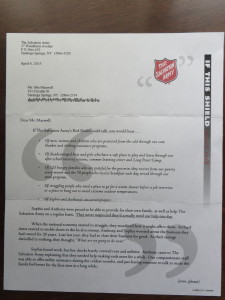
I gave a fair-sized gift to my local Salvation Army this past holiday season, and was happy to do so. (I wanted a particularly enthusiastic bell ringer to get credit, so I found out his name, wrote it on the check, and dropped it off at the local center.) Inevitably, this has spawned a series of large donor mailings asking me to repeat with similar amounts.
I mentioned one of these mailings in an earlier post because the art direction on the outer envelope wasn’t particularly adept. But later I got a second mailing that caused me to dig deeper and I found some object lessons in what not to do if you’re a national not-for-profit and you want to customize mail for individual locations.
Why should you go to the trouble of localizing your appeal? Because local donors to a cause like the Salvation Army want to know their contribution is put to use in their community. Some years ago I did a localized campaign for the American Red Cross. It had an insert on emergency preparedness, which was variable. We didn’t talk about hurricanes in the Midwest, or rivers flooding in the Northeast. (With climate change, maybe we’ll soon have the same disasters everywhere and non-profits can save the money.) And there were statistics which were localized by county of number of people helped, first aid courses taught and so on. Even thought it was a national mailing, folks in Milwaukee would feel like it was about their local Red Cross.
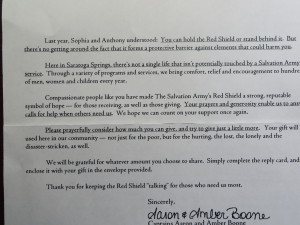
I expect the Salvation Army did some similar database research, but they don’t use it well in the copy. My own community of Saratoga Springs is not mentioned till the second page of the “if this shield could talk” letter. Who are the 125 hungry families and 70 people who eat breakfast? Is that in Saratoga? (To read this and other copy details, click on the images to enlarge them.) I suspect this is just a flub: the numbers are appropriate for a town our size, but somebody forgot to plug in the name of the town. As a copywriter I’m well aware that the story of Sophia and Anthony is not local, but blending in local statistics would have blurred that line and made for a more compelling narrative.
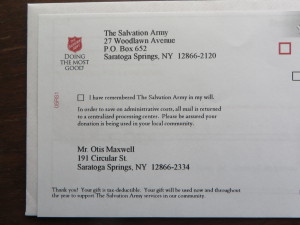
I’m also not easy with the qualifying statement (on the letter and the response form) that “In order to save on administrative costs, all mail is returned to a centralized processing center. Please be assured your donation is being used in your local community.” Well, first of all, that processing center (bad word—as a generous donor I don’t want to be “processed”) is in Albany, the nearest big city, so I don’t have a problem with it. Second, why don’t you say “in Saratoga Springs” or “in Saratoga County” instead of “your local community”? I have a very strong hunch that including this statement, thus raising an objection where one might not have existed, results in fewer donations that a mailing without that statement.
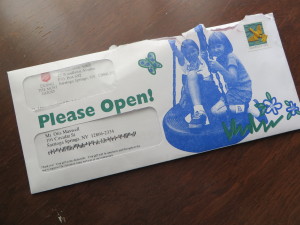
Then the second mailing arrived, which is about sending kids to Long Point Camp in the Finger Lakes. I’ve previously written about the difficulty of “send a kid to camp” programs—that’s a very hard sell compared to feeding a homeless family and you really have to paint a picture of the kid’s desperate situation. So now we have this outer with the message “Please Open!” (I think they could have come up with a better teaser, no?) and two white kids in a tire swing. Is this a variable picture? It’s true that my community is pretty lily-white so maybe so. But why a tire swing? Can’t they afford real play equipment at this camp, which probably isn’t very safe if they’re using discarded tires?
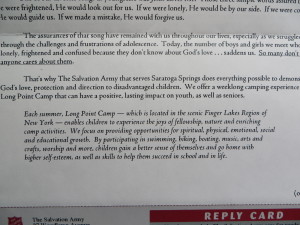
Moreover, why are we sending them away to camp in western New York when Saratoga County is chock-a-block with camps and rustic destinations? Or to Lake George, next county up the Northway? I feel like this effort is probably designed for donors who live in a big city, so when you mail to a resort area it really exhibits a tin ear.
I don’t have it in for the Salvation Army. I love these guys. I wrote fundraising campaigns for them many years through the Grizzard Agency, and contributed a pro bono effort to get donations after the Los Angeles riots of the early 1990s. But they have offered up a picture perfect example of what can go wrong with a localized campaign, and I’m sharing it as a bit of advice as well as others who think about localizing their national campaigns.